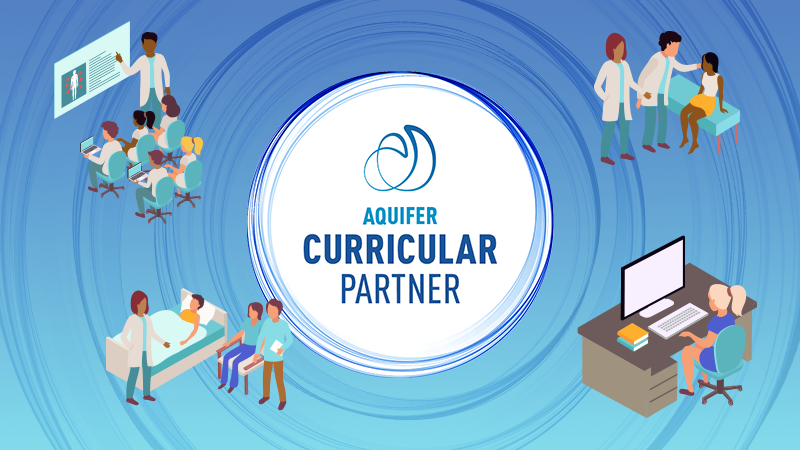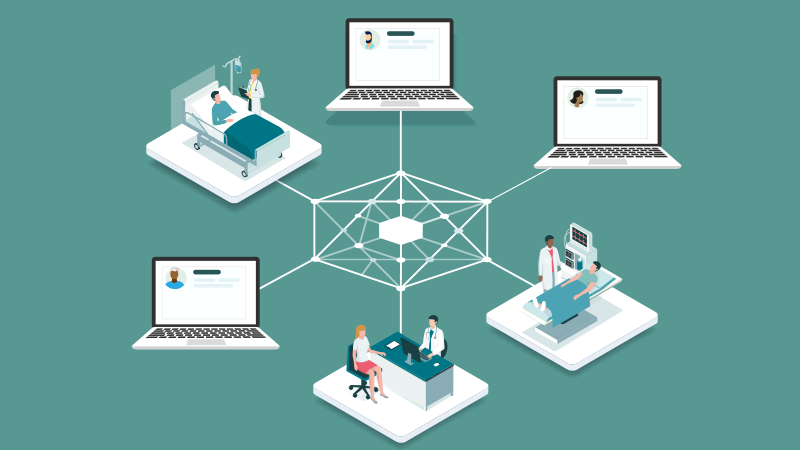In order to address these concerns, the Aquifer Osteopathic Task Force has developed Active Learning Modules for five Aquifer Signature cases (as of May 20, 2023):
- Family Medicine 10: 45-year-old male with low back pain: Active Learning Session
- Family Medicine 15 (General Surgery): Right Upper Quadrant Pain: Active Learning Session
- Family Medicine 19: 39-year-old male with epigastric pain: Active Learning Session
- Pediatrics 06: 16-year-old male preparticipation evaluation: Active Learning Session
- Family Medicine 32: 33-year-old with painful cycles: Active Learning Session
These sessions promote the integration of osteopathic principles in a clinical environment and help clinical educators – especially those who do not have additional training in Osteopathic Manipulative Medicine (OMM) or Neuromusculoskeletal Medicine (NMM) – teach OMT with confidence.
Anatomy of the Aquifer Active Learning Modules
Aquifer Osteopathic Active Learning Modules are specially designed teaching tools for clinical educators. Although created for 3rd-year students in a primary care setting, they can be adapted to a variety of learning environments. They assume no advanced training in NMM either, making them easy for all faculty to adopt into their teaching.
Each Active Learning Module includes four components: a facilitator guide, a student guide, clinical case extensions, and anatomy and OMT citations. Sessions are designed to be used in the flipped classroom model, with students are expected to review the associated Aquifer case before the session. The learning objectives for these modules focus on differential diagnosis, diagnostic work-up, the osteopathic exam, post-op complications, and the application of OMT.
The facilitator guide provides in-depth teaching prompts, points of emphasis, and suggested resources. Clinical Case Extensions are part of every facilitator guide and are a great way to get students to sharpen their clinical reasoning skills. These pre-written discussion questions extend the learning into a new scenario to get students to think on their feet. The student version provides an outline of the session and the same suggested resources but does not get the details of the Clinical Case Extension, as seen below.
While the Osteopathic Active Learning Modules are ideal for small groups (3 to 12 individuals), they can easily be tailored for larger groups as well.
Ostepathic Active Learning Modules in Action
Practical & Engaging Sessions Improve OMT Skills
Philadelphia College of Osteopathic Medicine
At the Philadelphia College of Osteopathic Medicine, Erik Langenau, DO, MS, and Robert Lloyd, DO, incorporated Aquifer Family Medicine 15: Right Upper Quadrant Pain and the accompanying Active Learning Module to help students improve their OMT skills. This particular Active Learning Module focuses on applying osteopathic principles and practices in the care of a surgical patient and is designed for a 60-minute long session.
Dr. Lloyd set up the session to first review the core concepts of the differential diagnosis, the five osteopathic models of patient care (biomechanical, respiratory-circulatory, metabolic-energy, neurological, and behavioral), and somatic dysfunction. These five models of patient care are used to develop the differential diagnosis and develop a treatment plan.
The feedback from these sessions was overwhelmingly positive from both faculty and students. Students reported that they found the sessions both fun and practical, and as an added bonus, they found that is made for excellent preparation for COMLEX PE. Both students and faculty found it especially helpful to be able to incorporate resources that they were already familiar with into the sessions, which was very easy for them to do.
Faculty also reported that the Active Learning Module was not only an effective teaching tool but also a good reminder to bring OMM and OMT into teaching more regularly. One of the key points that Dr. Langenau makes is that these modules are to remind clinical educators that they can confidently incorporate OMT into their teaching and organize the lesson. He notes, “It is a tool to help you be more confident. It’s designed for clinicians who haven’t used OMM in some time and want to incorporate it.”
Enhancing Confidence & Competence in OMM
Touro College of Osteopathic Medicine – Harlem
At Touro College of Osteopathic Medicine – Harlem, the faculty used the Aquifer Pediatrics 06: 16-year-old male pre-participation evaluation case and the accompanying Osteopathic Active Learning session to create an engaging, efficient, and effective session where students were encouraged to use an osteopathic lens to look at a particular case and enhance their competence and confidence.
According to Dr. Barbara Capozzi, Clinical Dean at Touro COM, the goal of this session was to have students think outside the box. She wanted to get students to apply osteopathic philosophy and knowledge, broaden history taking, be more inclusive and consider what other contributory factors were at work. Furthermore, students were encouraged to an osteopathic structural exam and interpret the findings, diagnose appropriately, and enhance their OMT skills.
“The active learning module allows students to apply their core osteopathic concepts and information learned from pre-session assignments to new and more complex clinical scenarios.”
– Barbara Capozzi, DO, CNS, Clinical Dean, Touro College of Osteopathic Medicine – Harlem
During the session, the preceptor made use of the provided Clinical Case Extension discussion questions, included in the Active Learning Modules. By prompting students with “what if” statements, they were able to get students to dig deeper and apply their OMT skills and osteopathic philosophy and knowledge.
More Tips for Teaching with Aquifer
Another way that Touro COM enhanced the learning experience was by requiring students to submit an OMM Summary Statement after the zoom session. This summary statement incorporates all osteopathic principles and OMT. The statement required students to write the history, physical exam, differential diagnosis, definitive diagnosis, OMT modalities, and a treatment plan. This statement was then reviewed by an OMM faculty member.
Dr. Capozzi also recommends tailoring Aquifer content to your learners, based on the requirements of the institution. One of the things that she has found most effective is finding an Aquifer case with the same diagnosis as a real patient that students have seen in the clinic and having them compare the two.
References
References
AACOM 2021 Annual Meeting presentations:
- Integrating Osteopathic Principles and Practice in Clinical Cases in a Remote Setting
- Presenters
- Barbara Capozzi, DO, CNS, Clinical Dean & Associate Professor, Family Medicine, Touro College of Osteopathic Medicine, NY Harlem Campus
- Jeremy Shugar, DO, Year 3 OMM Course Director, Touro College of Osteopathic Medicine, NY Harlem Campus
- Presenters
- Faculty Resource: Osteopathic Considerations Active Learning Modules
- Presenters
-
- Erik Langenau, DO, MS, Professor of Family Medicine, Chief Academic Technology Officer, Director for Teaching Support and Professional Development, Philadelphia College of Osteopathic Medicine
- Robert Lloyd, DO, FACOS, Associate Professor of Surgery, Philadelphia College of Osteopathic Medicine, South Georgia Campus
-
- Presenters




